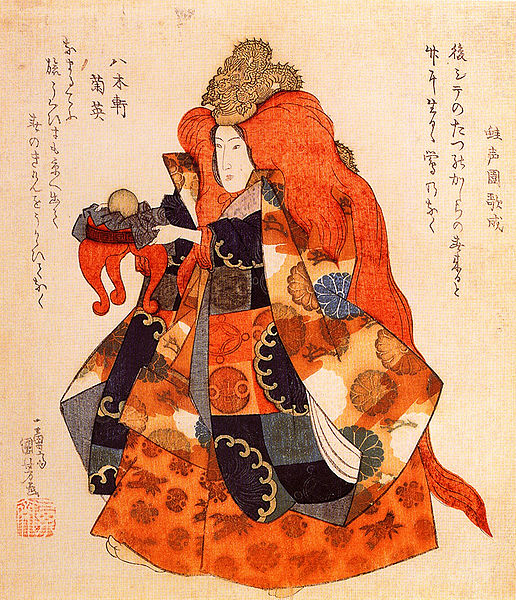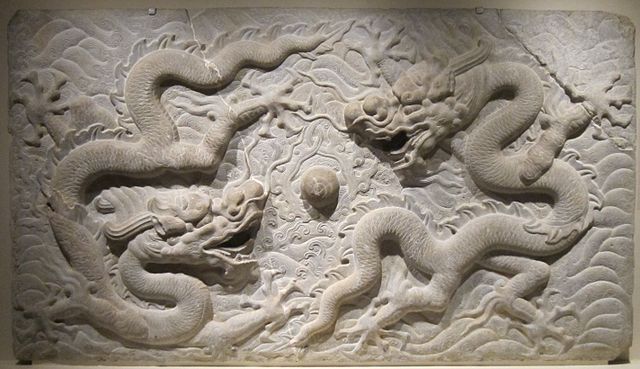Esoteric meanings of the dragon
Alchemy
Museaum Hermeticum 6 :
The draogn biting its tail is
similar to the Ouroborus
In spiritual alchemy, there are the earth - dragon of the Rebis and the dragon biting into his tail. Picture 2 of the 'Book of Lambspring' shows a fight with a dragon.
Hinduism
In the Vedas, Indra fights against the snake or dragon - asura Vritra, which is why he carries the nickname Vritrahan (Vritra-slayer).
In Nepal, Bhairava is depicted along with a dragon.
Greece
In greek mythology the dangerous Dragon Ladon(Hesperiodos) guards the tree with the golden apples.
Typhon is here the earth-dragon. The Python is represented here as a dragon snake.
In the greek Argonaut - saga the Golden Fleece in Kolchis on the Black Sea in the grove of Ares is guarded by a dragon.
China
Chinese Ming dragon relief
In the mythology of China the dragon has more than 100 names.
(In the Chinese Kungfu martial arts, the dragon style is based on a special understanding of the movement).
In contrast to the european dragons, the dragon is seen here rather as a powerful deity and less as a malicious creature.
He is also a house of the zodiac, and he is one of the four legendary creatures of the four cosmic directions (Red Phönix Zhuque - South, dragon Qinglong East, black Warrior Xuan Wu - North, white Tiger Baihu West). The dragon is the male counterpart of the female phoenix.
The dragon is, according to the philosopher Wang Fu, composed of nine beings: head of a camel, eyes of a demon, ears of a cow, horns of a deer, neck of a snake, belly of a shell, claws of an eagle and the soles of a tiger.
The 117 sheds of the dragon-body are considered as of a carp. The dragon is also said to be able to change size and color and to move around in the sky and on the earth.
In China, 9 types of dragons are distinguished: the mighty horned dragon, the winged dragon, the heavenly dragon, the spiritual dragon, the dragon of the hidden treasures, the winding water dragon of the lakes, the yellow dragon rose of the water to give the knowledge about the writing. A so-called 'homeless dragon' lives in the oceans or in the marshes and mountains.
The dragon Lóng is the most powerful of three chinese dragons. The Qinglóng (jap. Seiryū) is a blue-green dragon. In addition, there are still the hornless sea dragon 'li' and the weak dragon of the marshes 'Jiao'.

Longnü with pearl - Daughter of
the dragon king from the bottom
of the sea
Dragonking
As dragon kings count among other things a group of four dragons governing four lakes in the north, east, south and west (Longwang).
- Ao-yun : dragon king of the western ocean
- Ao-chin :dragon king of the southern ocean
- Ao-shun: dragon king of the northern ocean
- Ao - kuang: dragon king of the eastern ocean and their rulers.
Dragon kings have five legs with five claws and golden sheds but no wings.
Many dragon names end with 'long'. Exceptions are for example
- Hong (pinyin: hóng; W-G hung : 'Rainbow') - a two-headed dragon or a rainbow snake
- Shen (pinyin: shèn; W–G shen; 'Giant clam') - A form-changing dragon or sea monster, who was believed to be creating Fata Morganas
- Bashe (pinyin: bāshé; W–G: pa-she; 'Ba - Snake) - A phyton-like serpent eating the elephants
- Teng (pinyin: téng; W–G: t'eng) or Tengshe (pinyin: téngshé; W–G: t'eng-she; 'high flying snake') - a flying dragon without legs
The ruler Huizong of the Song Dynasty classified five - colored dragons as dragon kings :
- Azure dragon (Qinglong) : Spirits and compassionate kings .
- Cinnabar-red Dragon (Zhulong or Chilong) : Spirits and kings who give blessings on lakes.
- Yellow dragon (Huang long) : Ghosts and kings who positively hear all the requests.
- White dragon (Bailong) : Spirits and virtuous and pure kings
- Black dragon (Xuanlong or Heilong) : Spirits and kings of the depths of mystical waters
A general classification :
- Huáng Lóng: The yellow dragon, he was supposed to be the first dragon.
- Tiānlóng(Tian Lung): Heavenly dragon, who lives with the gods. .
- Shén Lóng(Shen Lung): Ghost dragon who controls the weather
- Dìlóng(Ti-Lung): Earth dragon who lives subterranean.
- Fúcánglóng(Fucan Lung or Chen Lung): Underground Dragon woh guards the treasures and places of strong energy.
- Nie Lóng: Evil dragon that brings ruin
- Jiāolóng: Crocodile dragon, which can change its shape.
- Pánlóng(Pan Lung): Winding serpent-like river dragon
- Fēilóng und Ying Long: Winged heavenly dragon
- Qīng Lóng: Azur dragon symbolizing the east
- Lóng Wáng(Wang Lung), Dragon king who dominates the waters.
Long-Wang is the king of the dragons. He lives in a palace on the seabed. In Taoism, the circular point between the legs is also called the 'sea bottom'.
In yoga a Drachentochter would correspond more to a Devi Rakini or Chakini and less a Dakini.
These names may therefore have a secret meaning regarding in the control of the Chi. For example, the universal forces 'yin and yang' in China have also the esoteric names 'Ilong and Oe'.
Buddhism
With the arrival of Buddhism in China were the most benevolent aspects of the dragon changed and matched to the more evil Naga, except the dragon king 'Long Wang', whose palace is at the bottom of the sea, and whose daughter is mentioned positiv(in the Lotus Sutra). In Daoism corresponds the 'bottom of the sea' to an energy-point between the legs, which is also the 'gate of death'.
The 'Great Drum - Sutra' mentions the dragons at the very beginning: At one time the Buddha stayed in the Anāthapiṇḍika Garden of the Jetavana Park in the city kingdom of Śrāvastī, along with 500 large Bhikṣus, as well as 100,000 Bodhisattva - Mahāsattvas and a variety of gods, dragons, yakṣas and Gandharvas .... or ........ Like the great dragon, with its liberated spirit and its unfolded wisdom, they had completed their undertaking.
In Thailand, the Mangkon dragon is a water being. It belongs to the mythological animals from the snow forest (Himaphan) on the hillsides of mount Meru.
Zen
An aberration of Zen is the so - called dragon - Buddha, behind which a dragon head appears over the head. This dragon-form recalls the Sesha - Kundalini of Narayana.

Nidhöggr - from an icelandic manuscript
Nordic Mythology
Nidhöggr(Nidhögg, Nidhöggur, Nidhogg ; old nordic Níðhǫggr : The hate-filled beating) is a serpent-like dragon in Nordic mythology, which lives under the world tree Yggdrasil and punishes the dead.
He damages the tree down there on the trunk and roots. He accepts the words which the squirrel Ratatosk coneys from the eagle in the crown of the tree.
Prosa Edda adds that Nidhöggr lives along with many snakes in the fountain Hvergelmir, which is located in Niflheim under the third root of the world tree, and nails there at the root of the Yggdrasil, which is a symbol of the human soul.
In the Nibelungen song the hero Sigfried kills the Fafnir on the Gnita - heath, who has assumed the form of a lindworm.
The world-encircling Midgard snake of Nordic mythology bites into the own tail after the Gylfaginning 34, a part of the Snorra-Edda, and thus forms a world circle.
Sumerians
Mušḫušḫu (Muš-ḫuš-šu, Muš-rušu, Sirruš : Babylonian terrible snake) is as a snake dragon a mixed entity from the Sumerian mythology. He was also the accompanying animal of Enlil and Tišpak.
Iconically, Mušḫuššu was first presented as a double-horned serpent head with a scaly body. He had the front legs of a lion and the hind legs of an eagle. At the end of the long and upright tail he had a scorpion stick.
Avesta
In Avesta, Kərəsāspa appears as a dragon-killer of the dragon Aži Sruvara. He also kills the sea monster Gandarəβa (or Gandarw).
Kabbala
The Sepher Jetzira states in chapter I : 2. The heavenly dragon, TLI (theli), is placed over the universe like a king on the throne.
Bibel
Tannin (Hebrew dragon) is translated as sea monster, monster or also with snake. Tannin is the primeval dragon who, like the Leviathan, lives in the sea and is shattered by YHWH.
Among the West-semites, tannin is a dragon-like monster. He is fought by the Canaanite goddess Anat.
In the Bible the insurrection of the angels is caused by the dragon tannin or by the serpent mentioned in Isaiah 51: 9.
In Psalm 74:13, Tannin, together with the beast Leviathan (Ijob 40: 25-41, 26), with Rahab (Job 26:12), Behemoth (Ijob 40: 15-24) and various sea-mammals (Jonah 2, 1-11) form the group of biblical monsters.
The Apocalypse speaks in chapter 13: And I saw a second beast, with two horns, like a lamb, and which spoke like a dragon. Here is wisdom! He who has understanding, consider the number of the beast; for it is a man's number, and his number is 666.
Literature
- Mythologien der Welt: China, Tibet, Mongolei, Band 2, Michaela Haustein, ISBN-10: 3844226257 ISBN-13: 978-3844226256
- Mythical monsters, Harles Gould, 1834-1893, S. 212
- Chinese Dragon Names, Linguistics of the Tibeto-Burman Area Carr, Michael. 1990; 7 Kategorien: Regen-Drachen, Fliegende-Drachen, Schlangen-Drachen, Wug-Drachen, Korkodil-Drachen, Hügel-Drachen sowie verschiedene andere.
Weblinks
- Drachen in China(de)
- Dragons in China und Japan
- Dragonarticle
- en Wiki about the Dragon
- Drachen und Fabelwesen(de)
- de.Wikia : Drachenarten
- Dragons of fame
of Spirituality
universal-path.org
